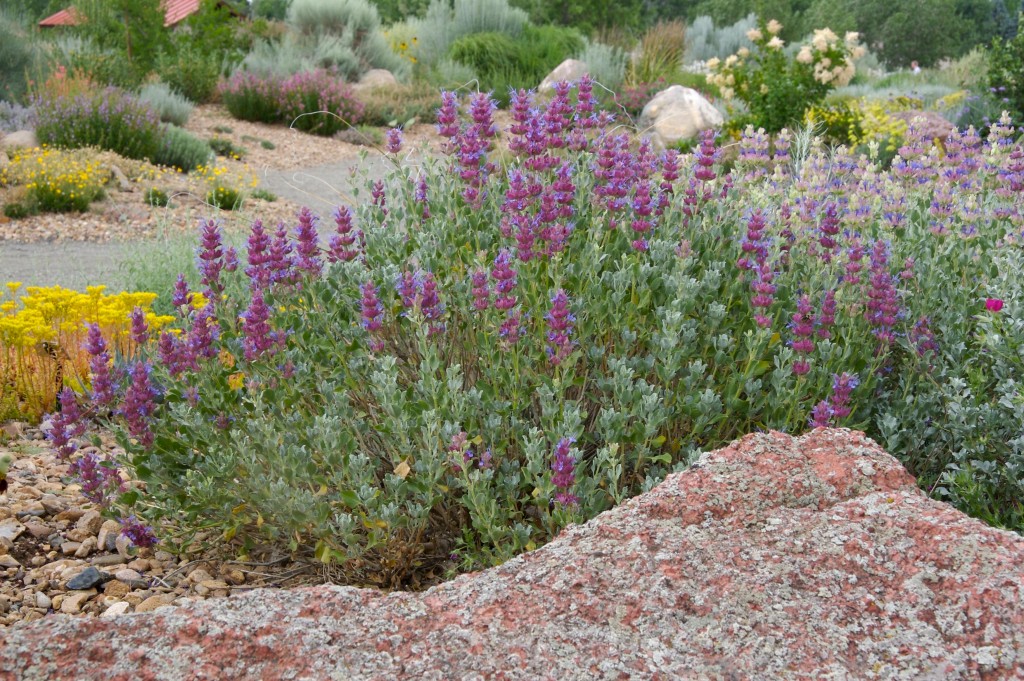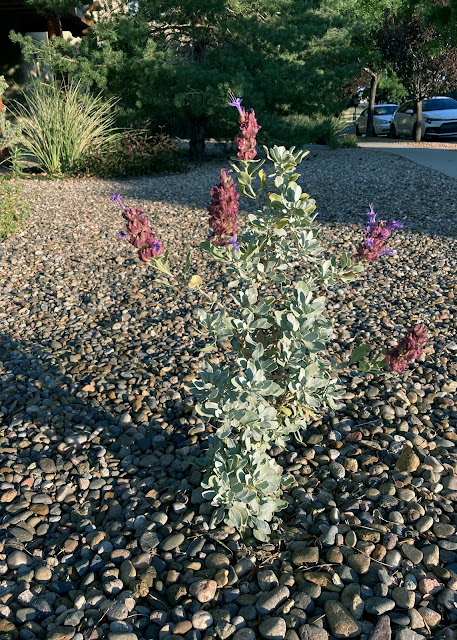From Payne's in summer 2019 and in spring 2020 -- all failed.
Tried again in summer 2025 and planted it under the Chinese privet in partial shade.
Here's my original couple years trying to get Mojave sage started, but failing:
I got one at Payne's nursery in summer 2019 to replace the Russian sage I took out at the front corner of the driveway. That original Mojave sage died when we went away for 5 days in July and it wasn't watered.
As a new plant Mojave sage wants a lot of water and soft easy draining soil. As soon as it dries out a bit the soft silver leaves wilt badly.
I replaced it with three more and kept planting more as those failed too -- why admit failure? I planted them in a tight semicircle at the corner. This time I added lots of amendment soil. Only one survived.
I added two more from Payne's in spring 2020 and these two little ones failed.
I do water them quite a bit, at least to get them started. It's been an odyssey.
But the one that lived looked great and flowers all summer long. Even the fading flower spikes looked good. It did not survive the winter and in spring 2021 it was gone.

 |
| Just planted, May 2025 |
Here's what the Santa Fe Botanical Garden says -- note that it says shade or partial shade, unlike other info that says full sun (and the Botanical Garden's plants are in full sun):
Mojave sage is native to desert mountains and grows on dry slopes, in piñon-juniper or pine woodlands, often in decomposed granite, at elevations from 5,000-10,000 ft. It should be planted in nutrient-poor, well-drained soil.
It grows best in dry shade or partial shade of trees.
It needs only minimal water after it is established. Soil that is too rich or too much water promotes lush growth, but short-lived plants. Cut back the plant when it is dormant.
 |
| Blooming at Santa Fe Botanical garden 7/26/19 |
As a new plant Mojave sage wants a lot of water and soft easy draining soil. As soon as it dries out a bit the soft silver leaves wilt badly.
I replaced it with three more and kept planting more as those failed too -- why admit failure? I planted them in a tight semicircle at the corner. This time I added lots of amendment soil. Only one survived.
I added two more from Payne's in spring 2020 and these two little ones failed.
I do water them quite a bit, at least to get them started. It's been an odyssey.
But the one that lived looked great and flowers all summer long. Even the fading flower spikes looked good. It did not survive the winter and in spring 2021 it was gone.
➰ ➰ ➰ ➰ ➰ ➰ ➰ ➰ ➰ ➰ ➰ ➰ ➰ ➰ ➰ ➰
More general info:

Mojave sage is 24″ tall with a width of at least the same. It takes a couple of growing seasons for it to gain this stature. It has intensely aromatic silvery-green foliage. Blooms all summer and into fall. Good drainage is essential especially in winter
The semi-evergreen foliage adds winter interest. Once this salvia is established, a good fall pruning after flowering helps maintain its shape and keeps it from becoming too woody.
Soil Moisture: it needs moderate watering to xeric, once established -- it's the "getting established" phase that is a fine balance between too wet and too dry, and my failures have probably been due to watering issues.
Hardiness: USDA zones 5-10
Culture: Loam or sandy soil -- the amended soil and the compacted dirt at the corner of the driveway is not that free-draining!
Hardiness: USDA zones 5-10
Culture: Loam or sandy soil -- the amended soil and the compacted dirt at the corner of the driveway is not that free-draining!

